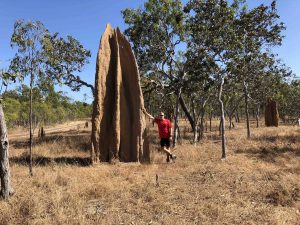Griffith University has teamed up with Australia’s most famous family of conservationistsin order tounearth and develop lifesaving medications to combat human diseases.
Research scientists fromNatureBank, Griffith’s biodiscovery resource, were recently granted access to the 330,000-acre Steve Irwin Wildlife Reserve (SIWR) in Far North Queensland on the back of the relationship forged between Griffith Institute for Drug Discovery (GRIDD) researchers and Steve and Terri Irwin many years ago.
Thereserve, which is made up of 35 different ecosystems, provides a habitat and refuge for a vast array of not only fauna but also flora. The unique biodiversity that is protected within thereserve has the potential for being the source of future human medicines.

Assoc Prof Rohan Davis in Steve Irwin Wildlife Reserve.
NatureBank,locatedatGRIDD, is adrug discovery platform that isbased on natural products (small molecules from nature) that are derived from Australian biota. This precious resource enables ground-breaking and innovative work at GRIDD on not only drug discovery projects, but also agrochemical, nutraceutical and cosmeceutical research.
“Naturebankis used by collaborators, both locally and from around the world, for finding small molecules from nature that are unique, have interesting biological activity, and hopefully will one day make a lifesaving drug,”NatureBank’sAcademic Lead Associate Professor Rohan Davis said.
“I am sure there will be lots of interesting chemistry and biology in these new plant samples, some of which we hope can be exploited against a raft of different human diseases” said Rohan. Researchers at GRIDD and abroad are looking for new anti-cancer, anti-infective, and anti-inflammatory compounds from nature.
“Examples of drugs from nature include paclitaxel (from the Pacific Yew tree bark), which is used in the treatment of breast, ovarian and non-small cell lung cancers;Eribulin(based on a natural product from a marine sponge) that is currently used for treating metastatic breast cancer; and of course the famous antibiotic, penicillin (from amicrofungus), that is used to treat various bacterial infections.”
The recent four-day expedition to the SIWR by Griffith was led byAssociate ProfessorDavis, andresulted in the collection and taxonomic identification of >50 plant samples that are endemic to this remote location and could potentially hold the key to developing cures for cancer, Parkinson’s and other infectious and neurological diseases.
Associate Professor Davis saidNatureBank’sbiota (>30,000 samples) and screening libraries [extract (15,000) and fraction (75,000) libraries] and reputation as having the best natural product resource in the southern hemisphere put it in a strong position to discover potential new medicines from the recently collected SIWR plants.
Associate Professor Davis said having the Irwin’s support was integral for GRIDD to carry on its vital drug discovery work.
“Terri has visited our team at GRIDD andBindihas spent a day in the lab with me a few years ago, so it’s great to build on that relationship by being the only group doing drug discovery expeditions within the Steve Irwin Wildlife Reserve,” he said.
Terri Irwin, Owner of Australia Zoo said itwas anhonourto work withAssociateProfessor Davis and his team and to support their research that may go on to help develop cures for cancer and diseasessuch asParkinson’s.
“It’s incredible to think that the Steve Irwin Wildlife Reserve could be home to a unique plant species that could hold the key to unlocking potentially lifesaving medications,” Terri said.
“This highlights the importance of nature and just how vital conservation of our flora and fauna is. Steve’s dream was to have the cleanest water, the freshest air and wildlife in abundance; but most of all, he wanted a future for our children and this research could have such a huge impact on future generations.”
NatureBank’scollected plant samples from the reserve are expected to be processed within the next threemonths, andwill end up in the unique extract and screening libraries at stored at GRIDD. These libraries are regularly shipped off to Europe or the US or other overseas destinations for further screening to determine their potential as sources of new drugs of the future.
